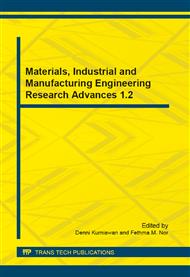[1]
Edwards, R., Sohal, A.S. The human side of introducing total quality management: Two case studies from Australia, International Journal of Manpower, Vol. 24 Iss: 5, p.551 – 567, (2003).
DOI: 10.1108/01437720310491080
Google Scholar
[2]
Zairi, M, Total quality management sustainability: What it means and how to make it viable. (2002).
Google Scholar
[3]
Zairi, M., and Alsughayir, A. A. The adoption of excellence models through cultural and social adaptations : An empirical study of critical success factors and a proposed model. Total Quality Management & Business Excellence, 22(6 ), 641-654, (2011).
DOI: 10.1080/14783363.2011.580654
Google Scholar
[4]
Boynton, A. C., and Zmud, R. W., An assessment of critical success factors. Slogan Management Review, p.17–27, (1984).
Google Scholar
[5]
Rockart, J. and Bullen, C., A primer on critical success factors, Center for Information Systems Research Working Paper No 69. Sloan School of Management, MIT, Cambridge, Massachusetts, (1981).
Google Scholar
[6]
Jabnoun. N., and Al-Tamimi. H., Measuring perceived service quality at UAE commercial banks, International Journal of Quality & Reliability Management, Vol. 20 No. 4, pp.458-472, (2003).
DOI: 10.1108/02656710310468614
Google Scholar
[7]
Badri,M., Abdulla, M., and Al-Madani, A., Information technology center service quality: Assessment and application of SERVQUAL, International Journal of Quality & Reliability Management, Vol. 22 No. 8, pp.819-848, (2005).
DOI: 10.1108/02656710510617247
Google Scholar
[8]
Jabnoun, N., and Khalifa, A., A customized measure of service quality in the UAE, Managing Service Quality, Vol. 15 No. 4, pp.374-388, (2005).
DOI: 10.1108/09604520510606844
Google Scholar
[9]
Jabnoun. N, and AL Rasasi. A., Transformational leadership and service quality in UAE hospitals, Managing Service Quality, Vol. 15 No. 1, pp.70-81, (2005).
DOI: 10.1108/09604520510575272
Google Scholar
[10]
Zaramdini,W., An empirical study of the motives and benefits of ISO 9000 certification: the UAE experience, International Journal of Quality & Reliability Management Vol. 24 No. 5, pp.472-491, (2007).
DOI: 10.1108/02656710710748358
Google Scholar
[11]
Badri, M A., Davis, D. and Donna, D., A study of measuring the critical factors of quality management, International Journal of Quality and Reliability Management, 12(2): 36 – 53, (1995).
DOI: 10.1108/02656719510080604
Google Scholar
[12]
Saraph, J.V., Benson, G.P. and Schroeder, R.G., An instrument for measuring factors of quality management. Decision Sciences, Vol. 20 No. 4, pp.810-29, (1989).
DOI: 10.1111/j.1540-5915.1989.tb01421.x
Google Scholar
[13]
Al-Marri, Kh., Ahmed, A.M., and Zairi, M., Excellence in service: an empirical study of the UAE banking sector, International Journal of Quality & Reliability Management, Vol. 24 No. 2, pp.164-176, (2007).
DOI: 10.1108/02656710710722275
Google Scholar
[14]
Magd,H. , Hamza, S. Critical Success Factors for Achieving Organizational Excellence in the Middle East: Engineering Firms Perspectives, e-TQM College Working Paper Series WP- 010201, (2007).
Google Scholar
[15]
Ahmed, A.M., Staff suggestion scheme (3Ss) within the UAE context: Implementation and critical success factors, Education, Business and Society: Contemporary Middle Eastern Issues, Vol. 2 Iss: 2 p.153 – 167, (2009).
DOI: 10.1108/17537980910960717
Google Scholar
[16]
Nunnally, J. C., Psychometric theory (2nd ed. ). New York: McGraw-Hill, (1978).
Google Scholar
[17]
Hair . M, Research Methods for Business Student. UK: John Wiley & Sons. (2007).
Google Scholar
[18]
Sekaran M. and Bougie. M, Research Methods for Business: A Skill Building Approach. UK: John Wiley & Sons. (2010).
Google Scholar


